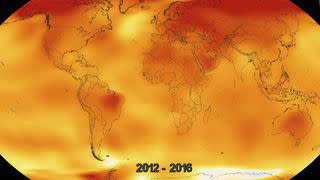One of the largest icebergs ever recorded just broke free of Antarctica

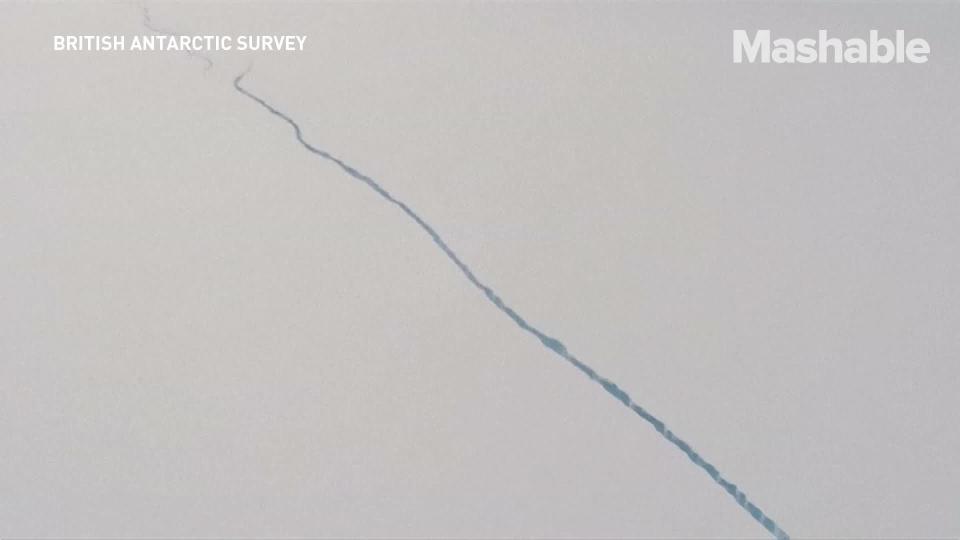
One of the largest icebergs ever recorded — measuring about the size of Delaware and containing a volume of ice twice the size of Lake Erie — has broken free from the Larsen C Ice Shelf in northwest Antarctica, according to scientists monitoring the region.
The iceberg weighs about a trillion tons, according to a team of researchers affiliated with a U.K.-based research project, known as Project MIDAS. While the iceberg calving event itself is likely mostly natural, it nevertheless threatens to speed up the already quickening pace of ice melt in the region due in large part to global warming.
The iceberg is about 2,200 square miles in area, or about the size of Delaware, Project MIDAS researchers said in a blog post on Wednesday morning. It will likely be designated "A68" by officials who track the movement of icebergs to avert shipping accidents.
SEE ALSO: Impending Antarctic iceberg is the size of Delaware, and extends 700 feet below the surface
"The calving of this iceberg leaves the Larsen C Ice Shelf reduced in area by more than 12 percent, and the landscape of the Antarctic Peninsula changed forever," the researchers wrote.
Breaking news! The iceberg has fully detached from Larsen C - more details to follow soon pic.twitter.com/pdSxDuAGjR
— Project MIDAS (@MIDASOnIce) July 12, 2017
Scientists have watched since 2014 as a fissure in the ice carved out a slice of the Larsen C Ice Shelf as if someone were taking a giant X-Acto Knife to the ice.
"The iceberg is one of the largest recorded and its future progress is difficult to predict," says Adrian Luckman, a professor at Swansea University and lead investigator of the MIDAS project. "It may remain in one piece but is more likely to break into fragments. Some of the ice may remain in the area for decades, while parts of the iceberg may drift north into warmer waters."
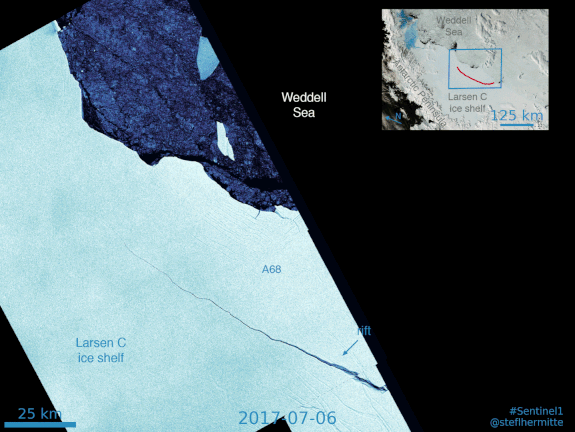
Image: Stef Lhermitte
The iceberg itself won't add to sea level rise, since it has already been floating in the water like an ice cube in a glass. But it may have significant consequences down the road by weakening the overall ice shelf and limiting its ability to hold back inland glaciers whose runoff does contribute to sea level rise.
The Larsen C Ice Shelf is located in the Antarctic Peninsula, which is one of the fastest-warming regions on Earth. While scientists have hesitated to pin this particular iceberg calving event to global warming specifically, the trends across parts of Antarctica, as well as the Arctic, are clear.
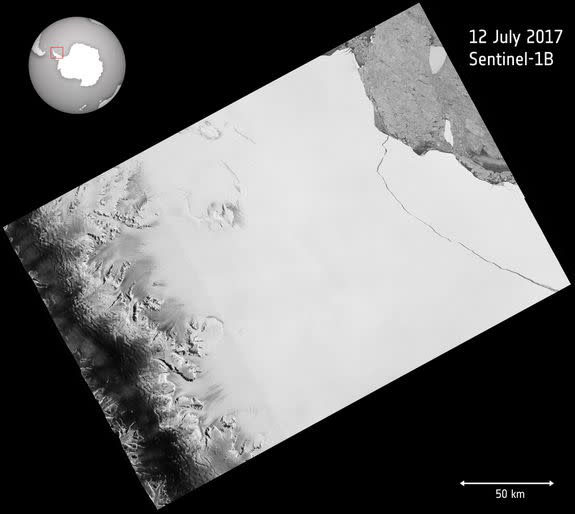
Image: esa
Ice shelves are retreating and weakening as sea and air temperatures climb, and mountain glaciers are speeding their path to the sea faster than predicted just several years ago. The result will be more significant and rapid sea level rise that will threaten the viability of coastal megacities, from Miami to Mumbai.
The Larsen C iceberg event has been one of the most closely-observed iceberg calving events in history, with data from a synthetic aperture radar aboard the European Space Agency's (ESA) Sentinel-1 satellite providing scientists with detailed observations of the motion of the sea and land ice in that region. Other ESA satellites and NASA platforms have also aided scientists in keeping track of this iceberg.
The radar onboard the Sentinel-1 satellite is able to detect subtle changes in ground movements and is used for both studying melting glaciers and ice shelves as well as earthquakes and other geological phenomena.
Scientists affiliated with a UK-funded research project known as Project Midas kept the closest tabs on the region, with researchers from NASA and other institutions also providing their expertise.
When viewed from the air, the fissure in Larsen C stretched all the way to the horizon, and was wide enough that you'd need a plane to cross it — with sections reaching at least 1,500 feet wide.
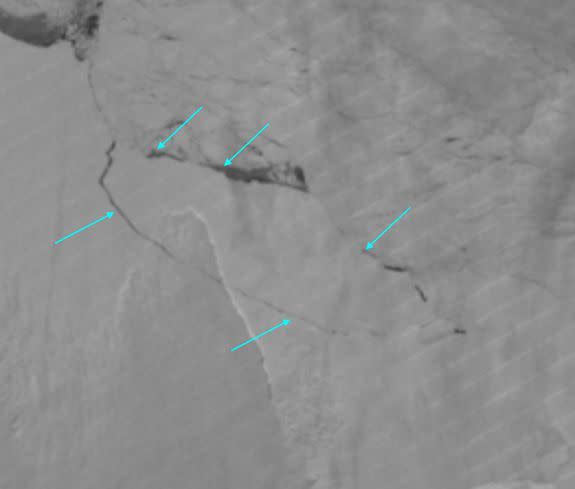
Image: project midas
The iceberg could last for several years, depending on whether it breaks up into smaller pieces or holds together, according to Mark Drinkwater, who directs the mission science division at ESA. He said there have been instances of icebergs that have circumnavigated the continent of Antarctica, and this iceberg won't melt quickly unless it moves far to the north near milder waters.
While the iceberg will not raise sea levels, it will alter the ocean waters in its vicinity by adding freshwater to the sea. It also can affect weather conditions nearby, and pose a danger to shipping routes, depending on its location, Drinkwater said..
How unusual is this?
Cracks and calving of ice from the front of an ice shelf are normal occurrences. Shelves are fed by glaciers and ice streams coming from the interior of the continent. They advance into the ocean until a calving event takes place.
The calving of an iceberg from an ice shelf in Antarctica would normally not be newsworthy, but because of the place where it occurred, the size of the iceberg, and the rapidity with which this went from a crack identified in 2014 to the calving event this week, this particular event is concerning to scientists who study the region.
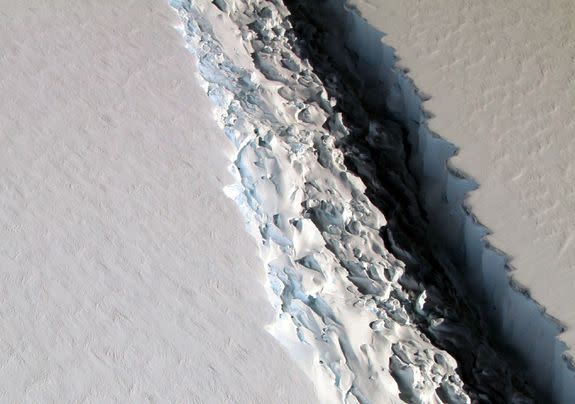
Image: nasa.
“This is a single piece, which is remarkable I guess because of it’s somewhat biblical proportions,” Drinkwater said.
Frequent, large calving events at the neighboring Larsen B Ice Shelf presaged that shelf's disintegration in 2002.
The Project MIDAS team has published research showing that the calving of this iceberg would reduce the size of Larsen C by more than 10 percent of its area, and leave its front at its most retreated position on record.
"This event will fundamentally change the landscape of the Antarctic Peninsula," the researchers wrote in a blog post.
The new position of the ice front, which is where the floating ice shelf meets the land-based ice behind it, is likely to be less stable than the previous configuration. This could speed Larsen C's demise, and make the ice sheet follow in the ill-fated footsteps of Larsen B, whose 2002 collapse was a wakeup call to scientists and the public that these massive ice structures can change quickly and seemingly without warning.
“Although this is a natural event, and we’re not aware of any link to human-induced climate change, this puts the ice shelf in a very vulnerable position," said Martin O'Leary, a Swansea University glaciologist and participant in the MIDAS project, in a statement.
"This is the furthest back that the ice front has been in recorded history. We’re going to be watching very carefully for signs that the rest of the shelf is becoming unstable.”
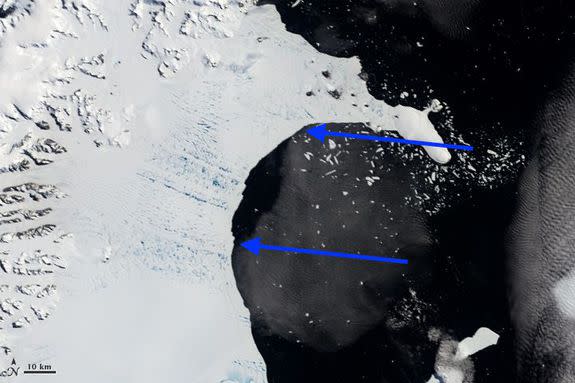
Image: nasa
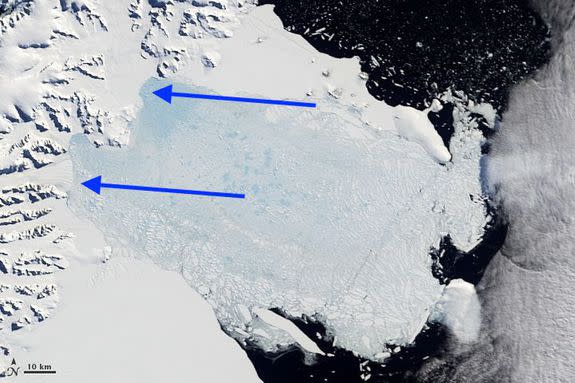
Image: nasa
Other ice shelves in the Antarctic Peninsula have either disintegrated or begun thinning and retreating as well, reflecting the rapid warming rates in the region.
"The demise of ice shelves in the Peninsula is well-documented and related to climate warming," said Eric Rignot, a professor of Earth System Science at University of California at Irvine and a researcher at NASA's Jet Propulsion Laboratory.
In fact, Larsen C is one of the last ice shelves in this region still standing. Larsen A disintegrated in 1995, Larsen B in 2002, the Wilkins Ice Shelf continued to break up through at least 2013, and according to Rignot, Larsen C and the George VI Ice Shelf are "not looking good." It may take years for us to know the fate of Larsen C, however.
Rignot said the crack in was able to propagate rapidly across part of Larsen C because the overall ice shelf has been retreating, and also thinned by at least 50 meters, or about 160 feet, in the past 20 years.
Despite losing such a large amount of ice at once, Larsen C is not likely to collapse right away, if at all, Rignot says. The shelf's compressive arch, which helps stabilize it, is still a few kilometers inland, he said.
However, another big calving event after this one could doom Larsen C. Were they each to slide into the sea, the glaciers held back by Larsen C would raise global sea levels by about 1 centimeter, or 0.4 inches. This is larger than that associated with the loss of Larsen B, which held back just 4 millimeters, or 0.15 inches, in sea level rise potential.
Scientists like Rignot have been sounding the alarm about ice shelf instability in the West Antarctic Ice Sheet as well. A collapse there could produce far greater amounts of sea level rise than similar events in other parts of the continent.
"As the wave of warming awake regions of Antarctica located farther south, the ice shelves will unleash larger amounts of land ice into the sea," Rignot said.
"This is the big story that people need to think about. What we are seeing right now does not have major consequences for sea level tomorrow, but it is part of a story where the sources of sea level awakened by climate warming get bigger and bigger with time."
According to Robin Bell, a climate scientist at Columbia University's Lamont-Doherty Earth Observatory, the iceberg should be viewed in the broader context of the changes taking place on our planet.
"It shows that we’re able to watch our planet shift and move much better than we used to, and we know that this is a part of the planet where temperatures are changing more than anywhere else, and [where] the first wakeup call that things could happen fast occurred.”
“It’s really the trends that matter, not an individual iceberg,” Bell said.
WATCH: It's official, 2016 was Earth's warmest year on record
